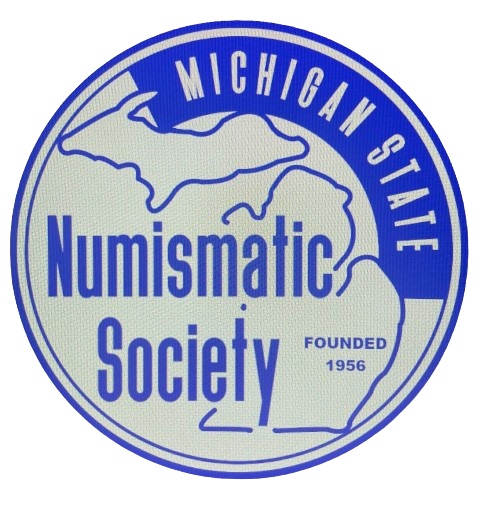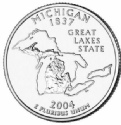MICHIGAN AND THE INDIANHEAD CENT
By Michael E. Marotta (MSNS 7935)
The Indianhead cent series (1858-1909) offers challenges and rewards to both beginning and advanced collectors. More than 1.8 billion were issued, so the collector who needs just one for a U.S. Type Set can find a high grade Mint State example from a high mintage year at a very reasonable price. The coin went through several changes in its early years. The collector pursuing an Indianhead Type Set needs these. Those who are building a complete Year and Mint set have only one “key” date (1877) to worry about and one “semi-key” (1909-S). Over its 50-year history, many varieties were created. These are the targets for more advanced collectors. In addition, the coin has a perhaps surprising connection to Michigan history.
The Indianhead cent was the work of James B. Longacre, chief engraver of the U.S. Mint from 1844 to 1868. Numismatic authorities Cornelius Vermeule, Walter Breen and Don Taxay uniformly condemn Longacre’s artistry, calling it simple and lacking inspiration. In fact, Longacre was an accomplished engraver whose portraits of America’s early heroes brought him to the attention of our nation’s leaders in the ante-bellum period.
Longacre was born in Delaware County, Pennsylvania, on August 11, 1794. He served an apprenticeship with a bookstore before being hired by Philadelphia engraver George Murray. From 1820 to 1827, he engraved portraits illustrating John Sanderson’s Biographies of the Signers of the Declaration of Independence. From 1831 to 1839 Longacre collaborated with James Herring to create The National Portrait Gallery of Distinguished Americans. This four-volume set presented 147 portraits. Among them were obvious choices such as George Washington, John Adams and Daniel Boone. Longacre and Herring also included contemporaries. In most cases, Longacre worked from oil paintings. In other cases, Longacre drew from life. Among those who sat for him were John C. Calhoun, Daniel Webster, James Madison, Andrew Jackson, and Lewis Cass.
Originally from New Hampshire, and a childhood friend of Daniel Webster, Cass served as a colonel in the Third Ohio Regiment during the War of 1812. In 1813, a brigadier general in the United States Army, he was appointed governor of the Michigan territory, a post he held until 1831. Cass was Andrew Jackson’s secretary of war (1831-1836). It was at this time that Longacre engraved his portrait. In the text of their opus, Longacre and Herring justified their choices of contemporary leaders. Their selection of Secretary of War Cass was on target. He went on to serve as minister to France, was one of Michigan’s senators from 1845 to 1857, ran for president in 1848 and was Buchanan's secretary of state.
Longacre won his appointment as chief engraver of the U.S. Mint on September 16, 1844, following the death of Christian Gobrecht. Despite his achievements as a portrait engraver, Longacre had no experience cutting dies. However, Gobrecht had already completed a rich set of hubs and dies. These are the “Seated Liberty” series coins that ran through most of the latter 19th century. At first limited to small modifications, Longacre’s proficiency improved. When the California Gold Rush motivated Congress to authorize the striking of $1 and $20 coins, Longacre was ready.
In 1857, Congress passed an Act to remove the legal tender status of Spanish, Mexican and other foreign silver and gold coins. The Large Cent was discontinued as part of this process. The first copper-nickel alloy Small Cents (1856-1858) carried Gobrecht’s Flying Eagle on the obverse and a wreath of cereals on the reverse. In 1858, Longacre created a new design.
The Liberty of the Indianhead cent is essentially the same face Longacre found successful on the $1 and $3 gold coins. Longacre modeled his work from a Greek statue called The Crouching Venus (Venus Acroupii). One Roman copy comes from the Vatican and apparently another Roman copy was known in Philadelphia. For the cent, Longacre gave Miss Liberty the ceremonial headdress of the Chippewa tribe of northern Michigan.
The Chippewa (Ojibwa, Ojibiway, etc.) occupy the western Great Lakes from the upper Mississippi to southern Ontario, across Minnesota, Wisconsin, and Michigan. Treaties between this powerful people and the federal government go back to 1785 and continue into the 1920s. In Longacre’s day, treaties with the Chippewa were current events. In 1855 alone, four separate negotiations were signed and published. Memos from Longacre and Mint director J. R. Snowden also cite the importance of Michigan’s rich copper deposits. In their view, it was fitting that a Michigan tribe should be honored on the new copper coin.
Longacre’s work complemented the Seated Liberty coinage of the 1800s. Although he died on January 1, 1868, his work continued for another generation. He designed the $1, $3, and $20 coins. He also created the entire series of minor coins of his time. His 3-cent silver and nickel coins ran until 1873 and 1889 respectively. (After 1873, his 2 Cent was discontinued. In 1889, the $1 and $3 ceased production.) With modifications, his Double Eagle of 1849 stayed on until 1907. The cereal wreath that Longacre placed on the Seated Liberty dime in 1860 continued through the Barber series until the Mercury dime of 1916.
References
DeLorey, Tom, “Longacre: Unsung Engraver of the U.S. Mint,” The Numismatist, October 1985.
Danziger, Edmund Jefferson, Jr., The Chippewas of Lake Superior, University of Oklahoma, Norman: 1978.
http://politicalgraveyard.com/ The Political Graveyard is created and maintained by Lawrence Kestenbaum, of Ann Arbor, Michigan.
McKenzie, Lee F., “Longacre’s Influence on Numismatic Art,” The Numismatist, December 1991.
Stewart, Robert G., A Nineteenth-Century Gallery of Distinguished Americans, Smithsonian Institute, 1969. This book is based on the original four-volume National Portrait Gallery of Distinguished Americans by Longacre and Higgins.









